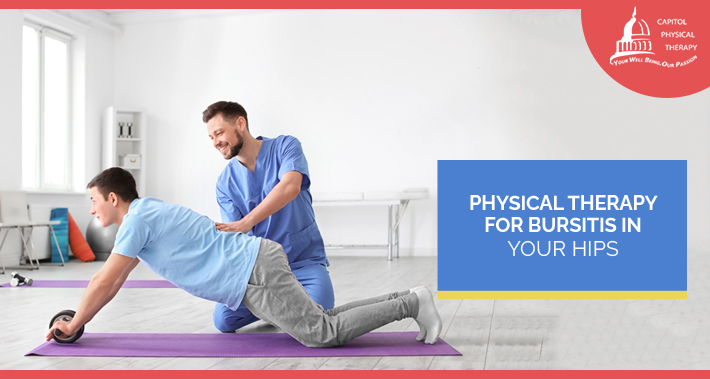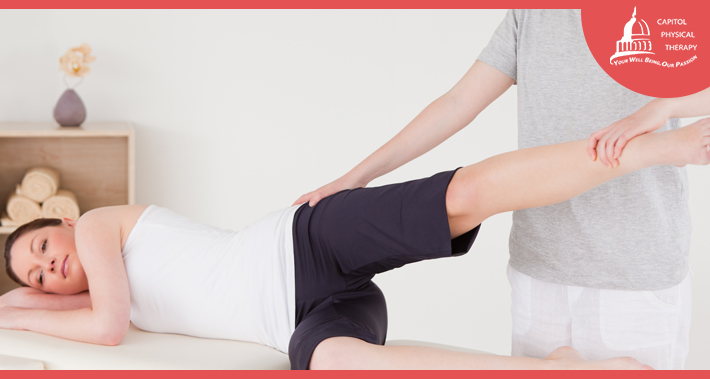
Hip bursitis can be a painful and inconvenient interruption in your life.
Pain when getting out of your car, while playing sports, or when sleeping on your side can all be signs of hip bursitis.
However, that doesn’t mean you can’t still enjoy your life.
Here at our orthopedic physical therapy in Washington DC clinic, we can help.
Physical therapy for bursitis can help you get back on your feet and back to the activities you love.
But for now, let’s take a closer look at hip bursitis.
What is it, what causes it, and how physical therapy can help.
What Is Hip Bursitis?
Your bursae are fluid filled sacs that pad most of the joints in your body.
You have over 150 bursae throughout your body.
This includes major ones in your knees, shoulders, elbows, and hips.
Each bursa protects your soft tissues – tendons, ligaments, and muscles – from the friction created by your bones as you move.
Most people have two major bursae in each hip.
The iliopsoas bursa is located on the inside of your hip, near your groin.
The trochanteric bursa is on the outside of your hip, along the knobby part known as the greater trochanter.
If either of these bursae becomes irritated or inflamed, it causes hip bursitis.
Many people find that hip bursitis limits range of motion or makes certain positions and movements uncomfortable.
How Does Hip Bursitis Feel?
The main symptom of hip bursitis is pain in the outer side of your hip joint and the surrounding area.
You may also feel pain in your thigh, buttock, or the outer side of your affected leg.
Common triggers for hip bursitis pain include:
- Getting up from a low seat, like the seat of a car
- Pressing the outer side of your hip with your fingers
- Lying on your hip
- Climbing stairs
- Walking or running
- Raising your leg up to the side
- Sitting in a posture that bothers your hips (eg. sitting cross legged)
RELATED: Physical Therapy Treatments For Poor Posture
What Causes Hip Bursitis?
Hip bursitis is usually the result of recurring stress or irritation of the hip joint.
Some of the common causes of hip bursitis:
- Repetitive action that irritates the bursa, like walking, stair climbing, or running on uneven surfaces
- Extra stress on the joint while walking due to an injury, leg length difference, or spinal problem
- Muscle weakness
- Poor alignment or posture
- Hip surgery or hip replacement
- Bone spurs in the hip
- Infection
- Autoimmune disorders, such as thyroid disease, rheumatoid arthritis, psoriasis, or gout
- Direct injury or trauma from being hit or falling on the hip
Seniors are often more prone to slip and fall injuries as they age.
This can be a result of multiple different health concerns, such as frailty, Parkinson’s disease, Huntington’s disease, or stroke.
RELATED: What Actually Happens During A Stroke?
As a result, your risk of hip bursitis may increase as you grow older.
RELATED: Reduce The Risk Of Falls & Learn Fall Recovery In Seniors
How Can Physical Therapy Help With Hip Bursitis?
Your physical therapist can help with everything from pain management to recovery and strengthening.
Typically, your physical therapist will assess your needs and provide a treatment program designed for you.
Physical therapy for hip bursitis usually includes a mix of in person and at home treatments and exercise.
Your healing will depend on several factors, including your age and the condition of your hip.
Following the program provided by your physical therapist can improve your progress and help you get back to your daily life.
Some of the ways your physical therapist can help:

1. Pain Management
Your physical therapist can address your pain through a combination of exercise, hands on therapy, and modifications.
They may use treatments like heat and cold therapy, dry needling, ultrasound, TENS, and taping in person to reduce pain.
RELATED: Dry Needling: Can It Help Relieve Your Pain?
Hands on therapy can also help with hip bursitis pain.
Your physical therapist will teach you to modify your movement and activities as necessary.
They will also provide strengthening exercises to reduce strain and protect your joints.
2. Flexibility Exercises
Tightness in your leg muscles or spinal muscles can also contribute to the pain of hip bursitis.
Muscle tightness related to weakness, injury, or other issues in another part of the body can impact your movement.
Hip bursitis can also cause you to tense or strain in your muscles as you compensate to avoid pain.
Your physical therapist can show you how to stretch at home to increase your flexibility.
3. Strength Exercises
Weakness or injury in your hip muscles often contributes to hip bursitis.
Your physical therapist can identify underlying muscular issues that might play a role in your pain.
They can do this by adjusting your posture, assessing your movement, and testing the strength of various muscles.
Your physical therapist will show you how to use resistance bands, weights, and cardio equipment to strengthen muscle groups.
4. Range Of Motion Exercises
Your physical therapist can work with you to restore and improve your range of motion.
Range of motion therapy often starts with passive exercises, where your physical therapist moves your body safely.
This can help to release tension in muscles and ligaments and to mobilize stiff joints.
As your hip bursitis improves, your physical therapist will teach you versions of these movements that you can do at home.
5. Goal Setting For Returning To Your Daily Activities
Your physical therapist will ask you about your everyday activities – your work, your hobbies, and your lifestyle.
As your hip bursitis improves, your physical therapist can show you maintenance and strength building exercises.
They will work with you to identify the daily activities you want to return to or new ones to add to your life.
Your physical therapist will help you learn how to return to activities safely, with modifications to protect your joints.
Book Your Appointment With Capitol Physical Therapy Today
If pain in your hip, buttock, or outer thigh is keeping you from your daily life, hip bursitis might be the problem.
A physical therapist can help with everything from pain management to restoring the strength and mobility you need to enjoy life.
To get a handle on your pain and get back to the things you enjoy book your appointment with Capitol Physical Therapy today.
1331 H St NW #200,
Washington, DC 20005
- https://g.page/capitolptdc
9560 Pennsylvania Ave. # 202,
Upper Marlboro, MD 20772
- https://goo.gl/maps/zjL4NnnuThRhrcS86
Capitol Physical Therapy offers orthopedic and other pain related solutions, with our versitile team of physical therapists in Washington, DC